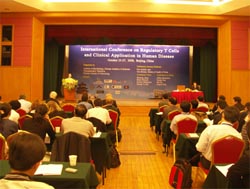
From 25 to 27 October, the International Conference on Regulatory T Cells and Clinical Application in Human Diseases, jointly hosted by the CAS Institute of Microbiology, Chinese Academy of Immunology and the Transplantation Tolerance, UK, was held in Beijing. World top experts in immunology gathered in China to address on the pending problems in this field.
Aims of the conference include: To update the latest development of regulatory T cells and their clinical application in human diseases including diabetes, GVHD, allergy, cancer and transplantation tolerance; to introduce the Chinese medical community one of the most cutting-edge topics in medicine; and, to foster the development of scientific exchange and cooperation between China and Western countries.
During the three-day conference, more than 40 immunologists form Europe, America, Japan and China gave reports on the latest research development, mechanism of suppression, immune intervention in cancer, autoimmune disease & allergy of regulatory T cells and up-to-date information on the clinical trials taken in the US, Germany and Italy.
More than 400 participants made extensive discussions on the topics and several presentations highlighted the current strategies to manipulate regulatory T cells as individualized medicine in preclinical studies and the results of clinical trials in various human diseases.
Dr. JIANG Shuiping, one of the Conference Chairs and professor with the King's College London, UK, revealed that since the regulatory T cells were discovered more than a decade ago, this conference should be recognized as the most successful event for immunology, coming with the largest number of world renowned immunologist, participants and research findings.







